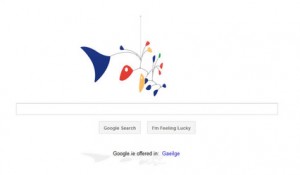Google’s Alexander Calder birthday
Google published a doodle today that commemorates artist Alexander Calder with an interactive sculpture that sways when a person tilts an accelerometer – equipped laptop.
Calder is famous for sculptures he called mobiles – hanging weights and struts that are carefully counterbalanced so they slowly drift into new configurations. The Google doodle, published on Calder’s 113th birthday, tilts when a laptop tilts and slowly spins if a person clicks and drags on the sculpture.
The swaying feature requires not just an accelerometer-equipped laptop but also a browser that can expose that information to a Web application. In my tests on a Mac this morning, that meant Chrome but not Safari or Firefox.
Google’s doodles began as whimsical drawings that provided a bit of variation on the company’s primary – color logo. They’ve steadily increased in prominence and sophistication, though, with an annual contest for students to draw their own and ever more dynamic doodles.
Examples include a playable Pac-Man game, a musical tribute to guitarist Les Paul, and leaping dancers.
The company now has a dedicated team of Google doodle artists. They get to recognize famous moments and people – and to help Google with its mission of evangelizing the world of Web programming and the abilities of its own browser.
Marissa Mayer, a Google executive with a penchant for art, touted the doodle on Twitter and on Google+.
“The amazing Alexander Calder logo is up! It’s a simulation of an actual working mobile – also, note the shadow below the search box and buttons” – Mayer said. “Click and drag to put the mobile in motion. Also, if you pick up your laptop and rock it from side to side, the mobile swings and moves (cool use of the accelerometer in most laptops).”
Jered Wierzbicki (software engineer at Google) said the inspiration for the mobile sculpture doodle came from a visit to the Museum of Contemporary Art in Chicago, where Calder’s objects ‘all beautifully balanced and proportioned, moving gently in the air currents like a whimsical metal forest.’
Wierzbicki said such abstract art can translate well into the software world and there was no better opportunity to present creativity than through the first use by Google of HTML5 canvas to create a doodle for its search homepage.
“This is Google’s first doodle made entirely using HTML5 canvas, so you need to use a modern browser to interact with it. It runs a physics simulation on the mobile’s geometry, and then does real-time 3D rendering with vector graphics. Only recently have browsers advanced to the point where this is possible.
“I like to think Calder would have appreciated today’s doodle, since we’re setting up shapes and abstractions and letting them act on their own. Hint – try it out on a laptop with an accelerometer!”
http://www.youtube.com/watch?v=j4jaY39kzog
A piece of kinetic art took the place of the usual Google logo to celebrate the 113th birthday of American artist and sculptor Alexander Calder.
Friday’s Google doodle shows a mobile, a type of kinetic sculpture that was invented by Alexander Calder. Mobiles take advantage of the principle of equilibrium and have objects hanging from rods. Kinetic art uses motion for an artistic effect.
Mobiles are usually brightly coloured free – moving creations in abstract shapes made from sheet metal. The mobile Google doodle sways on its own and can also be controlled by mouse gestures.
Calder was born on July 22, 1898 in Lawnton, US to a family of artists. While his father and grandfather were both sculptors, his mother was a painter.
He graduated with a degree in mechanical engineering from the Stevens Institute of Technology in Hoboken (New Jersey) in 1919. He then took art lessons. After a brief career in commercial art, Calder moved to Paris and put up an exhibition of a miniature circus with toy – like animals made of wood and wire. In Paris he formed associations with renowned artists and their influence helped him shape his art.
Calder was also a jewellery designer, an interest that developed when he was fashioning a wedding ring for his marriage with Louisa Cushing James. Besides his sculptures, Calder also illustrated a number of books. Besides mobiles, he also earned a name with stabiles, a type of stationary abstract sculptures.
With the years Calder also scaled up the size of his mobile and stabile installations. Calder died at the age of 78 on November 11, 1976. Two months after his death, Calder was honoured with United States’ highest civilian honour, the Presidential Medal of Freedom.
Interactive and animated Google doodles have now become a regular feature on the Google home page. The last such doodle was during the total lunar eclipse of June 15 – 16 when Google put up its first live doodle that refreshed itself every two minutes to reflect the stage of the moon.
